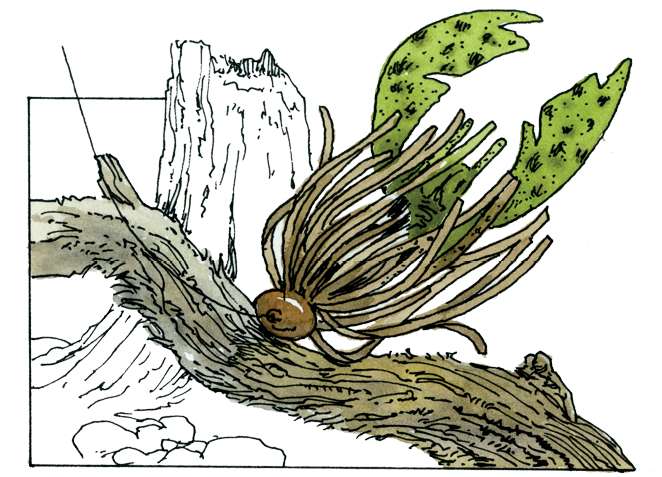
If you’re like most bass anglers, you didn’t start with the latest gear and a $90,000 boat. You started small, on small waters and perhaps without any boat at all. This edition of “Triple Threat” is a tribute to those times we should never forget or abandon.
Time of year: late September/early October
Body of water: farm pond (2 to 3 acres)
Depth: 15-foot maximum (5-foot average)
Surface temp: 72 to 75 degrees
Water clarity: 10 to 14 inches
Weather: clear and warm (high 75 degrees), wind 5 mph from the west
Structure/cover: dam and shallow flats, laydowns, shallow vegetation
Forage: bluegill, crawfish, bass, terrestrials
Notes: You’re walking the bank — no boat.
You may think of Bassmaster Elite Series pros as guys who race around big water wearing tournament jerseys, but most got their start on ponds like this. Here’s what three of the best have to say.
Let your bait be your eyes
Paul Elias
Laurel, Miss.
The 1982 Bassmaster Classic champ has the Elite Series record for heaviest catch: 132 pounds, 8 ounces from Falcon Lake in 2008.
Baits/tackle to use
Elias opts for a 3/8-ounce Mann’s Stone Jig (black and blue) with a 3-inch craw-style trailer (also black and blue). He’ll fish it on a 7-foot medium-heavy Pinnacle casting rod and 7.3:1 Pinnacle casting reel spooled with 15-pound-test White Peacock fluorocarbon line. “I can do a lot with that jig,” he says. “I can swim it or let it fall to the bottom and hop or crawl it. I can fish it around wood or grass, and I can work it shallow or deep. I’ll probably start by swimming it. For that, I like a medium retrieve that lets the craw do its thing and provide the action.”
First move
“I’ll start on the upper [shallow] end at daybreak and fish parallel to the bank. As the sun gets up, I‘ll explore offshore areas, steeper banks and anywhere I can find some shade.”
What to key on
“Visible cover will get whatever fishing pressure there is on the pond. I’ll use the jig to locate cover I can’t see and then to fish it thoroughly. That may be where the biggest bass live.”
Angle/boat position
“A lot of feeding takes place right on the bank in a pond like this. It’s important to make casts parallel with the bank to cover that water.”

Fish where the food is
John Crews
Salem, Va.
With an Elite win and nine Classic appearances, Crews has experience and accomplishments but is still one of the sport’s young guns.
First move
“The dam on a pond like this will always hold fish, so it’s a good place to start. I also like any obvious points or shady areas.”
Baits/tackle to use
For this assignment, Crews likes his twin ribbontail worm from Missile Baits, the Tomahawk. He’ll go with it in the bruiser color (black and blue laminate) and Texas rig it with a 1/8-ounce sinker and 5/0 Gamakatsu offset, round-bend worm hook. He’ll fish the worm on a 7-foot heavy action Cashion casting rod and high-speed (7:1) reel spooled with 14-pound-test Sunline Shooter fluorocarbon. “It’s a versatile bait I can swim or fish on the bottom or work through cover. I’ll start by swimming it, but if that’s not working, I’ll crawl it on the bottom. A lot of fish will eat it out of curiosity.”
Angle/boat position
“It’s important to work parallel to the shoreline on a pond like this. Bluegill, small bass, bugs, mice and other things a bass eats will be concentrated there to hide from predators.”
What to key on
“I expect to find a lot of bass cruising the bank at this time. That’s where most of their food is. I’ll move up to the edge of the bank slowly and quietly and make casts right along the shoreline or edge of the weeds.”

Wait for it!
Steve Kennedy
Auburn, Ala.
Since winning Rookie of the Year honors in 2006, Kennedy has won two Elite events, cracked 100 pounds three times and fished seven Classics.
First move
“I want to start at one of the corners of the dam — where the dam meets the bank. There you have shallow water and deep water close by. Another good place to start would be wherever a creek comes in — if it’s not silted in.”
Baits/tackle to use
Though tempted to select a buzzbait, Kennedy chose a 6-inch, twister-style plastic lizard (green pumpkin with a little chartreuse coloring on the tail). He’ll rig it Texas style with a 3/16-ounce sinker and 4/0 offset, round-bend hook. He’ll fish it on a 7-foot medium-heavy casting rod, a casting reel with a 6.2:1 gear ratio and 15-pound-test fluorocarbon. “I can fish that lizard like a buzzbait, swim it or crawl it on the bottom. Color-wise, I want it to look like a bluegill.”
Angle/boat position
“Sometimes the angle at which you present the bait means a lot. If you locate a piece of cover or structure that looks or feels good, try it from different angles.”
What to key on
“When you catch one or two bass, others may come in to find out what’s going on. You may not be catching fish on consecutive casts, though, because it takes them a little time to get there. Move slowly and quietly, and let them come to you.”





